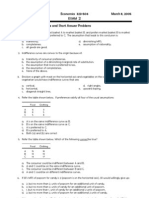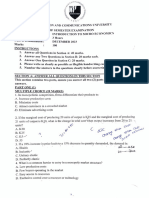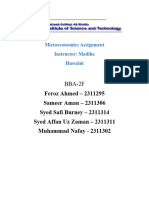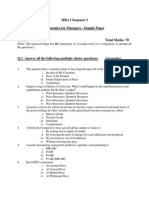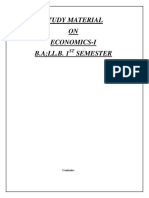0 ratings0% found this document useful (0 votes)
117 viewsAssignment - Unit 1 and 2
Uploaded by
ashishtiwari353694Copyright
© © All Rights Reserved
Available Formats
Download as DOCX, PDF, TXT or read online on Scribd
0 ratings0% found this document useful (0 votes)
117 viewsAssignment - Unit 1 and 2
Uploaded by
ashishtiwari353694Copyright
© © All Rights Reserved
Available Formats
Download as DOCX, PDF, TXT or read online on Scribd
You are on page 1/ 3
Principles of Microeconomics
Generic Elective – BA/B.Com (Prog.) V Semester
Assignment
1. State whether true, false or uncertain. Also explain.
a) Demand is relatively elastic when price and total expenditure on the good move in
the same direction.
b) If a consumer faces a zero price for good X, the budget line is parallel to x-axis.
c) Indifference curves are negatively sloped because more is preferred to less.
2. Why don’t two indifference curves intersect each other?
3. Why are ICs convex to the origin?
4. My marginal rate of substitution between a round of golf and a game of tennis is 6.
Which is more valuable to me and why?
5. Price of Y is Rs. 3 per unit and price of X is Rs. 6 per unit and consumer’s income is Rs.
3000. The consumer spends his whole income on X and Y. What is MRSXY at the
consumer’s equilibrium.
6. Ram and Shyam like Vanilla and Chocolate ice-cream but Ram’s favorite is vanilla while
Shyam’s favorite is chocolate. Using the concept of marginal rate of substitution, explain
Ram’s indifference map for vanilla and chocolate ice cream will be different from
Shyam.
7. Consider a consumer who consumes only two goods namely flour and potatoes. Potatoes
are an inferior good. Can flour also be inferior good? Explain. If the price of flour falls,
illustrate the impact on the consumption of flour and potatoes using income and
substitution effect.
8. Draw the indifference map for the following cases:
a) Consumer A always consumes tea and sugar in a fixed proportion. She adds two
spoonfuls of sugar to one cup of tea. (IC map with sugar and tea as the two
commodities)
b) Consumer B who is only interested in the total amount of money she had. IC map
with Re. 1 coin and Rs. 2 coins.
c) Good X is an inferior good.
d) A good that gives zero utility
e) Good X is apples and Good Y is noise
f) A good that gives negative utility after 5 units of consumption
9. A consumer spends his entire income on petrol and all other goods. The price of petrol is
initially Rs. 2 per litre. The government now announces a subsidy on petrol of Re. 1 per
litre, for each litre of petrol purchased in excess of 10 litres. No subsidy is paid on initial
10 litres of petrol. How would this affect the budget line of a consumer whose income is
Rs. 100 a month?
10. Decompose the change in consumption of good X, which is an inferior good, into income
and substitution effect, for increase in the price of good X.
11. A consumer consumes apples and chips. If his income increases from Rs. 10,000 to Rs.
12,000 per month, show the change in equilibrium when:
a) Both are normal goods
b) Apples are a normal good and chips are an inferior good.
12. Why the quantity demanded for a good may either increase or decrease with a decrease in
price. Explain using the concept of income and substitution effects.
13. Karan, a college student has Rs. 500 a week to spend. He spends it either on pizza at Rs.
50 per pizza or on movies at Rs. 100 per ticket. Draw Karan’s budget constraint. Find the
rate at which Pizza can be traded for a Movie ticket. Draw each new budget constraint he
would face if:
a) He gets scholarship of Rs. 100 per week
b) The price of pizza falls to Rs. 25
c) The price of movie ticket rises to Rs. 125
14. Derive the demand curve for Giffen good using indifference curve analysis. Also show
the income and substitution effect.
15. Show the effect of change in price of Good X on consumer’s equilibrium when the price
elasticity of demand for Good X is unitary elastic. Use indifference curve analysis.
16. Distinguish between Income consumption curve and Engel curve? When are they
backward bending?
17. Show the effect of a cash transfer and an equivalent in-kind transfer on consumer’s
welfare using indifference curve analysis. Which one would the consumer prefer and
why?
18. I spend my entire income on sugar and salt. My demand curve for salt is inelastic. If the
price of salt rises, will I increase or decrease the quantity demanded of sugar? Why?
19. An excellent harvest causes apples to fall in price by 10 percent. Consumers buy 5
percent more apples. The decrease has caused the consumers to spend more or less on
apples? Why?
20. Rama spends 30 percent of her income on clothing when she is earning Rs. 10000 per
month. With an increase in her earnings to Rs. 15000 per month. Her expense on clothing
becomes 25 percent of her income. Is clothing an inferior good for her or not? Why?
21. “Demand increases, causing the price to rise. Higher prices cause demand to fall.
Therefore, prices fall back to their original levels”. True or False. Explain you answer.
22. The market demand and supply curves of a commodity are given by Qd =90 – 6P and
Qs = - 20 + 4P respectively. Find the elasticity of demand and supply at the equilibrium.
23. If the price elasticity of demand is -2, it implies that consumers would buy twice as much
good if price falls by 10 percent. True or False. Why?
24. Define income elasticity of demand. What is its range?
25. Price elasticity of demand can be different at different points on the demand curve.
Explain.
26. Discuss the concepts of tradeoff and opportunity cost in context of the production
possibility frontier model.
You might also like
- Economics for CFA 2024: level 1 in just one week: CFA level 1, #4From EverandEconomics for CFA 2024: level 1 in just one week: CFA level 1, #44.5/5 (2)
- Elasticities, Price Distorting Policies and Non-Price RationingNo ratings yetElasticities, Price Distorting Policies and Non-Price Rationing29 pages
- Micro Eco Additional questions Q bank (1) (1)-1 (1)No ratings yetMicro Eco Additional questions Q bank (1) (1)-1 (1)20 pages
- 2024.05.05 - 311 (Minor) - Microeconomics Assignment 2024No ratings yet2024.05.05 - 311 (Minor) - Microeconomics Assignment 202415 pages
- IIT Mandi Principles of Economics HS202 - 2 20-21 Odd Semester Ex.1 Section ANo ratings yetIIT Mandi Principles of Economics HS202 - 2 20-21 Odd Semester Ex.1 Section A13 pages
- Imi611s-Intermediate Microeconomics-1st Opp-June 2022No ratings yetImi611s-Intermediate Microeconomics-1st Opp-June 20227 pages
- II PU Newly Added Questions And AnswersNo ratings yetII PU Newly Added Questions And Answers29 pages
- Economics 323-506 March 8, 2005 Exam Part 1: Multiple Choice and Short Answer ProblemsNo ratings yetEconomics 323-506 March 8, 2005 Exam Part 1: Multiple Choice and Short Answer Problems4 pages
- SUPPLY_DEMAND_REVISION_WOKSHEET_CLASS-11No ratings yetSUPPLY_DEMAND_REVISION_WOKSHEET_CLASS-114 pages
- Practice Questions PGP Microeconomics For ManagersNo ratings yetPractice Questions PGP Microeconomics For Managers4 pages
- Principles of Economics Bank of QuestionsNo ratings yetPrinciples of Economics Bank of Questions5 pages
- Introduction To Economics Exercise Chapter TwoNo ratings yetIntroduction To Economics Exercise Chapter Two5 pages
- Your Results For - Multiple - Induvidual & Market DemandNo ratings yetYour Results For - Multiple - Induvidual & Market Demand4 pages
- Intermediate Microeconomics A Modern Approach 9th Edition Varian Test Bank - Download The Complete Set In PDF DOCX FormatNo ratings yetIntermediate Microeconomics A Modern Approach 9th Edition Varian Test Bank - Download The Complete Set In PDF DOCX Format50 pages
- Microeconomic Essentials Supplementary OSANo ratings yetMicroeconomic Essentials Supplementary OSA13 pages
- All chapters of Intermediate Microeconomics A Modern Approach 9th Edition Varian Test Bank are available for quick PDF download100% (5)All chapters of Intermediate Microeconomics A Modern Approach 9th Edition Varian Test Bank are available for quick PDF download49 pages
- OUR INSTITUTE QUESTION BANK of MICRO ECONOMICSNo ratings yetOUR INSTITUTE QUESTION BANK of MICRO ECONOMICS18 pages
- MUEA Final SEP I Sem QB Foundations of Micro Economics QB 2024-25No ratings yetMUEA Final SEP I Sem QB Foundations of Micro Economics QB 2024-256 pages
- Question Bank Consumer's Equilibrium and Demand Multiple Choice Questions: Choose The Correct AnswerNo ratings yetQuestion Bank Consumer's Equilibrium and Demand Multiple Choice Questions: Choose The Correct Answer37 pages
- Demand and Consumer Behavior: Dela Cruz, Gerielle Marie ANo ratings yetDemand and Consumer Behavior: Dela Cruz, Gerielle Marie A36 pages
- Topic 2. Market Forces Demand and Supply PDFNo ratings yetTopic 2. Market Forces Demand and Supply PDF24 pages
- Chapter 9 - Possibilities, Preferences and Choices.No ratings yetChapter 9 - Possibilities, Preferences and Choices.29 pages
- Question Bank Micro Economics 30jan2015No ratings yetQuestion Bank Micro Economics 30jan201510 pages
- Elasticity Concepts: Price Elasticity of Demand Income Elasticity Cross-Price Elasticity Price Elasticity of SupplyNo ratings yetElasticity Concepts: Price Elasticity of Demand Income Elasticity Cross-Price Elasticity Price Elasticity of Supply40 pages
- CAIE A2 Level Economics Theory Revision Notes - ZNotesNo ratings yetCAIE A2 Level Economics Theory Revision Notes - ZNotes1 page











